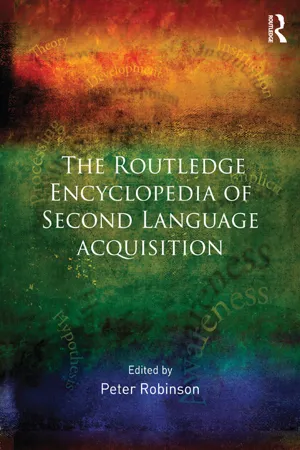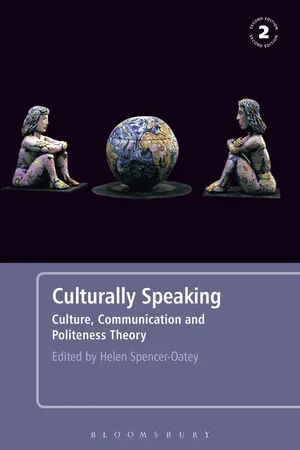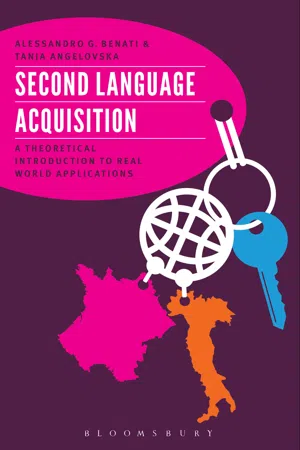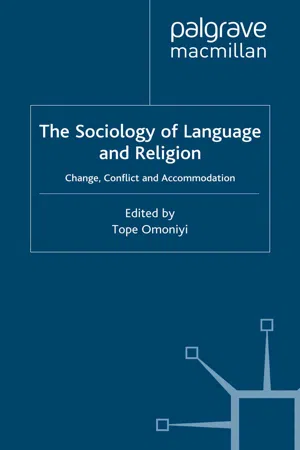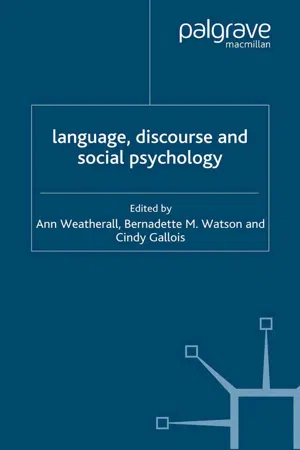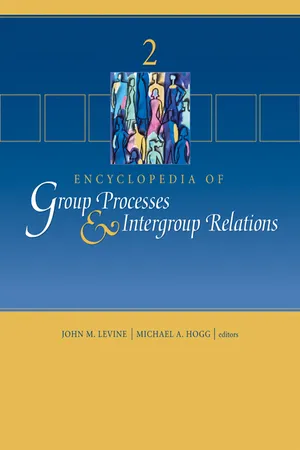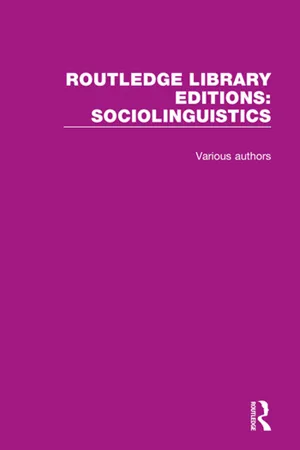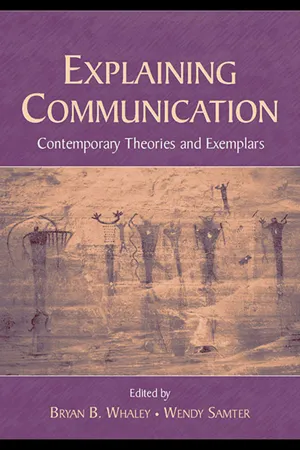Languages & Linguistics
Accommodation Theory
Accommodation Theory is a sociolinguistic concept that explores how individuals adjust their speech patterns to either converge with or diverge from the speech of their interlocutors. Convergence involves adapting one's speech to be more similar to the other person, while divergence involves emphasizing differences. This theory helps to explain how language is used to establish social identity and rapport in communication.
Written by Perlego with AI-assistance
Related key terms
1 of 5
10 Key excerpts on "Accommodation Theory"
- Peter Robinson(Author)
- 2012(Publication Date)
- Routledge(Publisher)
A DOI: 10.4324/9780203135945-1 Accommodation KimMarie Cole SUNY Fredonia In the field of socio-linguistics, accommodation is valued for its explanations and predictions of individual variation. As described below, second language acquisition (SLA) researchers have used accommodation to account for differences in learners’ language use with native speakers and how it accounts for some linguistic features of input. While empirical studies are relatively few in number, Tarone’s (2007) review includes accommodation among sociolinguistic theories of SLA. Beebe and Giles (1984) first present an overview of Speech Accommodation Theory (SAT) and its applications to second language acquisition. Its key propositions include convergence and divergence, active strategies used by learners based on their assessment of the perceived relationship between their language and that of their interlocutors. When speakers like or identify with their speakers or have an instrumental purpose for speaking, their speech converges. They are likely to model their speech on that of their interlocutor, using similar linguistic features. Conversely, when speakers feel a lack of identification or a perceived threat to their language, they accentuate linguistic differences, or diverge from their interlocutors. In terms of SLA, the model suggests that those learners who perceive the new language as a threat to their first language would not seek opportunities to practice the second and would therefore not develop second language proficiency. Conversely, learners, who see the second language as complementary to their first would achieve higher proficiency- eBook - PDF
- J.L. Mey(Author)
- 2009(Publication Date)
- Elsevier Science(Publisher)
Thakerar et al. ’s (1982) three-dimensional model of accommodation allows for a complex range of options and remains a core statement of the sociopsy-chological foundation of the theory. They introduced a distinction between psychological and linguistic accommodation, including the possibility that a speaker may converge linguistically while diverging psychologically. Coupland et al. (1988) expanded accommodation to a wider set of attuning strategies, specifically in health-and age-related communication, by which communicative dimensions other than language are accommodated to a speaker’s perceptions of an inter-locutor. Giles et al. (1991) explored the distinctions that have been made in Accommodation Theory, providing a detailed historical view of the devel-opment of the theory to that time. Further aspects of convergence and divergence are characterized, in-cluding uni-versus multimodal and subjective versus objective accommodation. They acknowledge the possibility that, given the multiplicity of linguistic and extralinguistic features involved in any interac-tion, a speaker may converge in some features and diverge in others. The weight of Accommodation Theory’s appara-tus thus expanded in the 1980s to cover the more nuanced findings that were emerging through empirical work. Elaboration of the theory has not extended greatly since then, doubtless in part because the models had already become very complex and not easily capable of further refinement. However, the basic insights of accommodation remain sound: that speakers accommodate their style to their audience. If we understand accommodation encompassing any style shift that occurs in response to an audience, the theory is a powerful explanatory model of style. 992 Speech Accommodation Theory and Audience Design It goes beyond the descriptive taxonomy and non-directional correlation in earlier sociolinguistic approaches to propose an explanation of what causes style shift. - eBook - PDF
Culturally Speaking Second Edition
Culture, Communication and Politeness Theory
- Helen Spencer-Oatey(Author)
- 2008(Publication Date)
- Continuum(Publisher)
Of course, speakers' appreciation of their own contexts of communication is often incom- plete; they may, for example, be unable to predict how hearers will judge their commu- nication strategies. This means that accommodating can often be fraught with uncertainties and, for example, miscarried attempts at convergence. Communication Accommodation Theory therefore has considerable relevance to our understanding of miscommunication (Coupland et al. 1991), particularly between social groups where normative expectations for talk are not fully shared. (I consider one instance in detail in the next section.) Finally in this section, it is important for us to recognize how accommodation research has begun to engage with discourse analysis and pragmatics, in place of the rather mechanistic descriptions of speech and language variables that it dealt with in its early years. The early studies, and so the early development of the theory, depended on quantitative measures. Convergence and divergence were quantified as shifting values of measurable variables, such as phonological or dialect standardness and the frequency of use of specific language codes. Quantification was important in establish- ing the basic claims of the model, for example that linguistic convergence is regularly associated with perceived solidarity, and divergence with psychological dissociation. But it is clearly the case that 'being accommodative' is realized through a very wide range of discourse moves and strategies, and that these are fundamentally interactive in nature. - eBook - PDF
- Grzegorz Dogil, Susanne Maria Reiterer, Grzegorz Dogil, Susanne Maria Reiterer(Authors)
- 2009(Publication Date)
- De Gruyter Mouton(Publisher)
Sociolinguistic factors in language proficiency 257 Sociolinguistic factors in language proficiency: phonetic convergence as a signature of pronunciation talent. Natalie Lewandowski 1. Adaptation processes in dialog Research on adaptation processes in dialog has developed within the framework of Communication Accommodation Theory ( CAT ), which was established in the 1970s, originally under the term “speech accom-modation theory” ( SAT , Giles 1973). SA theorists then started proposing new explanations for some aspects of the Labovian paradigm (Labov 1966) concerning the formality-informality of context. According to them, a lot of details could be explained by interpersonal accommo-dation processes. Furthermore, they called for a more detailed concept of context , which was a major term in sociolinguistic theory at that time. One of the specific goals was increasing the attention for specific dimen-sions of context, like language itself and the role of the receiver in the interaction (Giles, Coupland & Coupland 1991). Since then, many topics have been under the focus of SA researchers, involving the clarification of the motivations underlying speech, the constraints imposed on it and fin-ally their consequences for social interaction (Giles et al. 1991). Under the new name of communication Accommodation Theory, the range of topics has been extended to nonverbal behavior and general dimensions of discourse (Giles et al. 1987, cit. after Giles et al. 1991). Communication accommodation researchers, being nowadays placed at the interface between sociology, social psychology, sociolinguistics and communication, have also adopted a broader perspective of macro-variation to their studies, instead of solely concentrating on interindivi-dual exchange. - eBook - PDF
Second Language Acquisition
A Theoretical Introduction To Real World Applications
- Alessandro G. Benati, Tanja Angelovska(Authors)
- 2016(Publication Date)
- Bloomsbury Academic(Publisher)
Howard Giles’ Accommodation Theory (or Speech Accommodation Theory) shares several theories with the Acculturation Model, but it also has several other signi fi cantly different aspects. For Giles, motivation levels re fl ect how individual learners will de fi ne themselves and as a consequence how they change, adjust and accommodate their speech. The theory observes how speech patterns converge or diverge within different social interactions and group constellations. Central to this framework is the notion that speakers are motivated to adjust their speech when interacting with each other. They mainly accommodate their speech when they desire social approval and/or high levels of communicational ef fi ciency. Success will depend on the learners’ individual differences and environmental factors as well as each speaker’s available language repertoire. SLA extended: communicating in a world with bilinguals, heritage and multilingual speakers Given the mobility and migration so common today, as well as economic, trade, cultural, educational and other kinds of encounters – individuals pursue their goals and exchange information by communicating both face-to-face and online in many international settings. These situations often require interlocutors to use a commonly shared or widely understood language, even if it is not their mother tongue. Such a helpful tool is called a ‘lingua franca’ (Jenkins 2015, Seidlhofer 2011). English is a widely used lingua franca. According to 2012 Eurobarometer 386, it is by far the language that most Europeans are likely to speak as their fi rst (that is, most fl uent) foreign language (32 per cent) (Eurobarometer 386: 20). Speakers might use the lingua franca in different ways depending on the various linguistic practices they have been exercising previously, different S L A extended: communicatin g in a w orld with bilin g uals, herita g e and multilin g ual speakers - eBook - PDF
The Sociology of Language and Religion
Change, Conflict and Accommodation
- Tope Omoniyi(Author)
- 2010(Publication Date)
- Palgrave Macmillan(Publisher)
1 Introduction: Change, Accommodation and Conflict Tope Omoniyi The concepts of change, accommodation and conflict that are our focus in this volume are not new to the older traditional disciplines of sociology, social psychology and religion where they are experiential social phenomena that both characterize and define the relationships between two states of being, contexts or persons/groups. While change frames discussions of the transition between and into states, contexts and selves, conflict and accommodation are probable responses to such changes, one resisting and diverging the other embracing and con- verging. As a hybrid discipline, sociolinguistics had inherited these concepts but confined the experiential to language behaviour as we find when accounting for variation in different fields of linguistic analysis – phonology, lexis, morphology, syntax, pragmatics and dis- course. Giles and Powesland refer to the ‘individual speaker’s diversity of speech possibilities’ which warrant choice-making and modification aimed at ‘controlling the way in which he is perceived by the listener’ (1975: vi). They say that we accommodate in speech through speed of delivery, pitch range, phonological variables and vocabulary. These are all micro-level linguistic measures. The underlying thought then is the pursuit and preservation of harmony in society by managing the potential impact of social demarcations and difference based on speech performance. In the sociolinguistic literature, conflict has been theorized tradition- ally along social class lines, anchored as it were to Marxist thinking and especially the works of Marx, Lenin and Weber. Class and capitalism, technology, and division of labour-derived hierarchies have been cen- tral to articulations of conflict in the social sciences (Giddens and Held 1982). These demarcations and differences mostly served to identify 1 - eBook - PDF
- A. Weatherall, B. Watson, C. Gallois, A. Weatherall, B. Watson, C. Gallois(Authors)
- 2007(Publication Date)
- Palgrave Macmillan(Publisher)
Giles, H., Mulac, A., Bradac, J.J. & Johnson, P. (1987). Speech Accommodation Theory: The first decade and beyond. In M.L. Mclaughlin (Ed.), Communication yearbook 10 (pp.13–48). Beverly Hills: Sage. 46 language, accommodation and intercultural encounters Giles, H. & Coupland, N. (1991). Language: Contexts and consequences. Milton Keynes: Open University Press. Giles, H. Coupland, J. & Coupland, N. (Eds.) (1991). Contexts of accommodation: Developments in applied sociolinguistics. Cambridge: Cambridge University Press. Harwood, J., Giles, H. & Bourhis, R.Y. (1994). The genesis of vitality theory: Historical patterns and discoursal dimensions. International Journal of the Sociology of Language, 108, 167–206. Hecht, M., Jackson, R. & Pitts, M. (2005). Culture: Intersection of intergroup identity theories. In J. Harwood & H. Giles (Eds.), Intergroup communication: Multiple perspectives (pp.21–42). New York: Peter Lang Publishers. Hoerder, D. (1996). Nation and multiculturalism in German past and present: Comparative perspectives. Paper presented at the Nation-State, Multi-Ethnicity and Citizenship Conference. Montreal, Quebec, Canada. Homans, G. (1961). Social behavior: Its elementary forms. New York: Harcourt, Brace and World. Hornberger, N.H. & King, K.A. (2001) Reversing quechua language shift in South America. In J.A. Fishman (Ed.), Can threatened languages be saved? Reversing language shift, revisited: A 21st century perspective. (pp.166–194). Clevedon, Avon, UK: Multilingual Matters. Janssen, A. & Murachver, T. (2004). The role of gender in New Zealand literature: Comparisons across periods and styles of writing. Journal of Language and Social Psychology, 23, 180–203. Johnson, F.L. (2000). Speaking culturally: Language diversity in the United States. Thousand Oaks, CA: Sage. Johnson, M.L. & Doucet, P. (2006). A sharper view: Evaluating the vitality of official language minority communities. - John M Levine, Michael A. Hogg, John M. Levine, Michael Hogg(Authors)
- 2009(Publication Date)
- SAGE Publications, Inc(Publisher)
Originally, sociolinguists thought that such shifts were dictated by social situations. More for-mal situations, for example, might lead one to use more “correct” pronunciation than less formal situations. This idea was overturned, however, when Howard Giles proposed his speech accom-modation theory, now called communication Accommodation Theory. According to this theory, people are motivated to use accommodating lan-guage when they want to express similarity and attraction, and they do so when they believe their interaction partner has legitimate social status. Conversely, when people believe the social status of others is low or illegitimate, they are likely to use divergent language. In a now classic demonstration, Richard Bourhis and Howard Giles asked Welsh second-language learners, who were highly committed to their Welsh identity, to participate in a study on second-language learning. In one experimental condition, an English experimenter who employed received pronunciation (i.e., nonregional accented English) challenged participants’ reasons for studying Welsh: “Why study a dying language with a dis-mal future?” These participants answered in a broader Welsh accent, used more Welsh terms in their replies, and referred to their Welsh identity more often than those not so provoked. The Welsh L 512 Language and Intergroup Relations speakers’ divergent replies can be understood as attempts to maintain their ethnic heritage in the face of a threat from what they considered to be the illegitimately high-status English. There is now a wealth of evidence that such linguistic shifts are driven by motivations and per-ceptions of status relations between groups. In the case of intergenerational relations, the elderly commonly experience patronizing speech from younger generations.- eBook - PDF
- Various Authors(Author)
- 2021(Publication Date)
- Routledge(Publisher)
M., & Bourhis, R. Y. Towards a theory of interpersonal accom- modation through speech: Some Canadian data. Language in Society, 1973, 2, 177-192. Gudykunst, W. B. (Ed.). Intergroup communication. London: Edward Arnold, in press. Harre, R., & Secord, P. F. The explanation of social behaviour. Oxford: Blackwell, 1972. Heider, F. The psychology of interpersonal relations. New York: Wiley, 1958. Hymes, D. Models of the interaction of language and social setting Journal of Social Issues, 1967, 23, 8-28. Jones, E. E., & Davis, K. E. From acts to dispositions: The attribution process in person perception. Advances in Experimental Social Psychology, 1965, 2, 220-267 Kelley, H. H. Attribution theory in social psychology. Nebraska Symposium on Motiva- tion, 1965, 15, 192-238 Kelley, H. H. The process of causal attribution. American Psychologist, 1973, 28, 107- 128. Kelly, G. A. The psychology of personal constructs. New York: Norton, 1955. Labov, W. The logic of nonstandard English, Georgetown Monographs on Language and Linguistics, 1969, 22, 1-31. Lambert, W. E. A social psychology of bilingualism. Journal of Social Issues, 1965, 23, 91-109. Moscovici, S. On social representations. In J. P. Forgas (Ed.), Social cognition: Perspec- tives on everyday understanding. London: Academic Press, 1981. Moscovici, S., & Hewstone, M. Social representations and social attributions: From the 'naive' to the 'amateur' scientist. In M. Hewstone (Ed.), Attribution theory: Social and functional extensions. Oxford: Blackwell, 1983. Osgood, C. E., Suci, G. J., & Tannenbaum, P. H. The measurement of meaning. Urbana Illinois. University of Illinois Press, 1957. Platt, J. & Weber, H. Speech convergence miscarried: an investigation into inappropriate accommodation strategies. International Journal of the Sociology of Language, 1984, 46,. 131-146. Robinson, W. P. Language management in education: The Australian experience. Sydney: Angus & Robertson, 1978. Ryan, E. B. & Giles, H. - eBook - ePub
Explaining Communication
Contemporary Theories and Exemplars
- Bryan B. Whaley, Wendy Samter, Bryan B. Whaley, Wendy Samter(Authors)
- 2013(Publication Date)
- Routledge(Publisher)
CAT provides a particularly powerful theoretical framework for studying how gender identities are negotiated during the interaction and their influence on the communicative behavior of the participants. Gender is a salient group membership that has been shown to have a major influence on communication in many Anglophone contexts. In his study of the impact of gender on linguistic accommodation in radio phone-in programs in Jordan, Al-Khatib (1995) demonstrated the importance of gender in the type of language used by the broadcaster and his or her interlocutors. But he also revealed that accommodation depends largely on the speaker's social knowledge and his or her ability to vary speech style. In this study, it was more the broadcasters who accommodated to their interlocutors than the reverse. The author explained this by virtue of the goals of the broadcasters who aim at pleasing their audience as well as by their greater ability to vary speech style; to work as a broadcaster, they are required to speak Modern Standard Arabic as well as its colloquial variety.Communication in Organizations
Organizations offer a particularly interesting communicative context, oftentimes with strong situational norms and asymmetries in the status and power of the interactants. For most organizations, accommodation is also central to their relations with their customers and the public in general. Sparks and Callan (1992) applied CAT to the hospitality industry and showed how much a convergent style of communication with consumers is important for customers' satisfaction. This has been observed in a number of settings also where, for example, a travel agent accommodated her pronunciation to the different socioeco-nomically based language styles of her Welsh clientele (N.Coupland, 1984) and, in Taiwan, where salespersons converged more to customers than vice versa (van den Berg, 1986). These asymmetrical convergences are based on who holds economic sway at the time and are, of course, in accord with CAT predictions. Likewise, Cohen and Cooper (1986) showed that many tourists in the developing world (e.g., Thailand) do not expend much effort to acquire much, if any, competence in the language of the country visited, whereas locals in service industries (whose financial destiny is in many ways tied to tourism) often become convergently proficient in many foreigners' languages.
Index pages curate the most relevant extracts from our library of academic textbooks. They’ve been created using an in-house natural language model (NLM), each adding context and meaning to key research topics.
